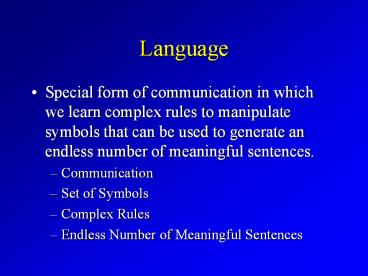Language - PowerPoint PPT Presentation
Title:
Language
Description:
Communication. Ability to use sounds, smells, or ... The Nativist Theory - Born to Talk ... parents provide corrective feedback as learning theory predicts ... – PowerPoint PPT presentation
Number of Views:21
Avg rating:3.0/5.0
Title: Language
1
Language
- Special form of communication in which we learn
complex rules to manipulate symbols that can be
used to generate an endless number of meaningful
sentences. - Communication
- Set of Symbols
- Complex Rules
- Endless Number of Meaningful Sentences
2
Communication
- Ability to use sounds, smells, or gestures to
exchange information.
3
Functional Properties
- Displaced Reference
- Productivity
- Prevarication
- Pragmatics
4
Structural Properties
- Phonology
- phonemes
- Semantics
- morphemes
- syntax
5
Prelinguistic Stage
- Birth to 1 year
- Crying
- Cooing
- Babbling
- Language Comprehension
- Ability to make discriminations not required by
native language gradually lost
6
Linguistic Stage
- 1 year and up
- Holophrases
- Infant-directed Speech
- Overextension
- Underextension
7
Vocabulary Development
8
Linguistic Stage
- Two-word combinations
- Telegraphic Speech
- errors of overgeneralization
9
Errors of Overgeneralization
10
Language Development
- 6 Months
- Vocalization with intonation
- Responds to human voices without visual cues by
turning his head and eyes - 12 Months
- Uses one or more words with meaning
- Understands simple instructions
- 18 Months
- Has vocabulary of approximately 5-20 words
11
Language Development
- 24 Months
- Can name a number of objects common to his
surroundings - Approximately 2/3 of what child says should be
intelligible - Vocabulary of approximately 150-300 words
- My and mine are beginning to emerge
- 36 Months
- Knows chief parts of body and should be able to
indicate these if not name - Handles three word sentences easily
- Has in the neighborhood of 900-1000 words
- About 90 of what child says should be
intelligible
12
Language Development
- 4 Years
- Knows names of familiar animals
- Names common objects in picture books or
magazines - Knows one or more colors
- Often indulges in make-believe
- 5 Years
- Can count to ten
- Speech should be completely intelligible, in
spite of articulation problems - Speech on the whole should be grammatically
correct - 6 Years
- Speech should be completely intelligible and
socially useful
13
Language Development
- 7 Years
- Should be able to tell time to quarter hour
- Should be able to do simple reading and to write
or print many words - 8 Years
- All speech sounds, including consonant blends
should be established - Should be reading with considerable ease and now
writing simple compositions - Can carry on conversation at rather adult level
14
Language in Middle Childhood
- Vocabulary continues to increase receptive
vocabulary is about 40,000 words by age 10 - Phonemes mastered and aspects of intonation
better understood - Increases in mastery of grammar and syntax, along
with improvement in pragmatic skills - Development of metalinguistic awareness
- Increasing sophistication in language play
15
Theories of Language Acqusition
- Learning Theories
- Nativist Theories
16
LANGUAGE DEVELOPMENT Language as a
Learned Skill
- Learning theory based on behaviorist theories of
learning - operant conditioning, modeling - Language viewed as behavior learned like other
skills - Parents also provide models of advanced language
that child then imitates
17
LANGUAGE DEVELOPMENT Language As A
Learned Skill
- Criticisms of theory
- - parents do not explicitly teach rule systems
- - pace of language development difficult to
explain through learning principles - - ignores evidence that humans biologically
predisposed to - detect language stimuli
18
The Nativist Theory - Born to Talk
- Noam Chomsky language is innate human capability
- Language acquisition device (LAD) brain
mechanism specialized for detecting and learning
rules of language - Contains innate knowledge of universal grammar
19
The Nativist Theory - Born to Talk
- Specific physical structures in humans
specialized for producing/processing language - No single organ is LAD
- Constellation of several brain areas that are
specialized to process linguistic input and their
connections (Wernickes area, Brocas area)
20
(No Transcript)
21
How Language Works
- Left hemisphere more verbal side. We literally
speak with half a brain. The dominant location of
language for more than 95 of people, including a
sizable majority of left-handers - Right hemisphere responsible for the inflection
and overall musical quality that lend important
emphasis to verbal communication
22
The Nativist Theory - Born to Talk
- Existence of sensitive periods for language
development supports nativist position - - children deprived of language have poorer
language skills - - older children and adults have greater
difficulty learning second language - - older children and adults show less
recovery from brain damage affecting language
areas
23
24
The Nativist Theory - Born to Talk
- Criticisms of nativist theory
- - parents provide corrective feedback as
learning theory predicts - - some exposure to language (i.e., TV) does
not produce normal language skills































